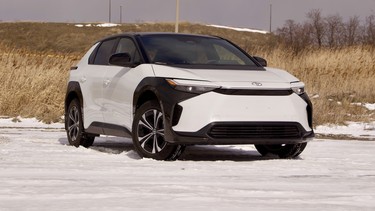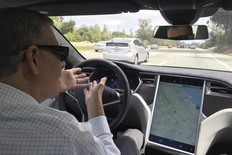EV Review: 2023 Toyota bZ4X
Late to the party, the new battery-powered sport cute has traditional Toyota qualities but lacks range

Article content
Toyota is a little late to the EV party. Everybody else was already well on their way to non-sobrietous disease state — that’s me inventing a new “woke” word — and lined up at the punch bowl for their second round by the time the world’s largest automaker joined the festivities. So now it’s catch-up time, the company promising to produce no less than 3.5 million battery-powered vehicles by 2030. It’s also working overtime on battery technology and is one of the leaders in developing solid-state batteries for electric vehicles.
Advertisement 2
Article content
But that’s the future. What about the here and now? Is their first BEV, the awkwardly-named bZ4X, up to the competition? How does it compare with the leaders in the segment, Hyundai’s Ioniq 5 and the Kia EV6? And does it possess all of the attributes we’ve come to expect from Toyota? Range Finder hit the highway to find out.
Range is a little less than the competition
We had a little problem determining the b4’s actual range because, well, Toyota decided, in its wisdom, that its EV didn’t need a battery monitor. In fact, there is no battery state-of-charge (SoC) gauge in the bZ4x anywhere — more on that in a minute — which is kinda like a gas car not having a fuel gauge (more on that in a minute too).
Advertisement 3
Article content
So, we cheated a little. We plugged the Toyota into a 125-kW ChargePoint station and read the battery condition from its SoC gauge. Then we went for a little ride and, and when we were done, plugged the bZ4X back into that very same charging point. Those in the know will immediately respond that said machines are not as accurate as the meters found in most EVs — that should be read every single EV we’ve tested save the Toyota — but one makes do with what one has. According to this calculation the bZ4X has a range of 250 kilometres at 5C. That compares to Natural Resources Canada’s 367-km rating for the new Toyota.
Working with the energy consumption meter — which the Toyota, for some reason, does include — its 27.7 kWh/100 km and 72.8 kilowatt-hour battery says it should have been good for 260 klicks before running out of Lithium ions. So, Range Finder will split the difference and call it 255 klicks. For those expecting more specific range findings, our apologies. We can only work with what we have.
Advertisement 4
Article content
It’s also worth noting that these tests were conducted on a brisk, sunny day with 5C weather. Whatever the case, according to Geotab.com, that would put the bZ4X’s maximum range somewhere between 270 and 280 kilometres in ideal conditions (that would be at exactly 20C). Either way, that’s not exactly a triumph in range anxiety reduction. On the other hand, a Hyundai Ioniq 5 tested later the same week had a 290 km range at 125 km/h when we tested the Hyundai in similar conditions.

The bZ4X doesn’t charge all that quickly either
The bZ4X’s maximum charge rate is 100 kilowatts and, in perfect conditions, it can supposedly recoup 80 per cent of its maximum charge in an hour. In reality — and by reality, I mean that 5C weather — it takes about twice as long. Poor cold weather charging is a known issue as Toyota originally released information noting that AWD versions — which use a different battery supplier than FWD version — should not be charged below -20C. Whatever the case, my tester never got much above 40-kW and even that measly peak rate didn’t last much past the 40 per cent SoC before dropping like a stone. By the time it got to 90 per cent, it was ingesting a picayune two kilowatts, which means that charging the last 10 per cent of battery would have taken about four and a half hours. Yes, on a 125-kW charger.
Advertisement 5
Article content
In fact, according to a test by Motor Trend, the AWD bZ4X can recoup that last 10 percent more quickly on a low-wattage AC home charger than plugged into a high-power DC fast charger. Toyota is legendarily conservative about anything that might compromise long-term durability and it would appear fast charging has been sacrificed in the quest for maximum battery life. Considering that battery life has not turned into the bugaboo that BEV critics predicted, it would seem a compromise too far.
That said, I don’t think this is the result of faulty technology but rather misguided mandate. Toyota is fixated on reliability. The company’s success depends on its reputation for reliability. And battery longevity, the experts are fond of saying, is sacrificed by high-speed charging. In other words, I think the bZ4X’s slow charging is on purpose, Toyota determined that their EVs match their ICEs for robustness. The problem for the company is that the worry about battery degradation has proved to be something of a false flag, BEV batteries, so far, lasting longer than predicted. In other words, Toyota is seemingly worrying for nothing and its conservatism is working against it. I suspect it will be corrected soon.
Advertisement 6
Article content
Recommended from Editorial
Now, about that missing State-of-charge meter
Toyota’s official counterargument to the lack of a “tank” gauge is that the bZ4X does have a range estimator and that’s all you really need.
I call bullshit. For one thing, the range meter works by predicting how far you can drive based on how far you just drove. If you’ve just been driving in town — where EVs get better range — and then head out on the highway, said meter is going to be hopelessly optimistic. For instance, I drove the bZ4X around very slowly for a while and the range meter excitedly claimed we had 416 km remaining when we were — I think, because, well, there’s no way to know — around 80 per cent SoC. I then drove down Ontario’s Highway 404 a few kilometres to my favourite Chargepoint. I topped it up to 90 per cent — from whence I sampled its slow charging rate at high SoC first hand.
Advertisement 7
Article content
When I was done, the range meter then displayed 302 kilometres remaining. That’s 100 kilometres less range with 10 per cent more charge, not exactly the kind of veracity that’s going to quell my range anxiety on a long trip. All electric cars need a SoC meter. If gas-fueled cars were similarly equipped — just a range remaining display and no fuel gauge — our highways and byways would have long been full of stalled petrol cars and range anxiety would not be a new phenomenon. The lack of a state-of-charge display is a big omission.
Compare the specs of similar EVs, including the Toyota BZ4X, Hyundai Ioniq 5, and more
So, the bZ4X is not a highway hauler. What does it do well?
A topflight all-wheel-drive system
Not many bZ4X owners are likely to take the mid-sized electrified ute off-road. But they could if they wanted to. The bZ was co-developed with Subaru — which sells it as the Solterra — and knows a thing or two about AWD. There’s an X-Mode that optimizes the output of the two 80 kilowatt electric motors — one powering each axle — after just a click of a button. It offers a choice of Snow/Dirt and Deep Snow/Mud modes. Snow/Dirt essentially acts like an e-diff across the two front wheels while Deep Snow/Mud “locks” all four wheels for an even distribution of torque to all four tires. Downhill Assist Control, meanwhile, limits speed as you descend steep hills. By any other name, Hill Descent Control would limit speed so sweetly.
Advertisement 8
Article content
Toyota’s new Grip Control, however, is completely unique. Essentially, an off-road cruise control, Grip Control allows you to set your speed — via a cruise control-like toggle that is on the centre console — whether you’re going uphill or downhill and no matter how slippery the terrain.
Advertisement 9
Article content
The interior is quite nice
My first impression of the bZ4X’s interior was not erroneous. It’s a lovely place to while away the hours. Oh, looking over the steering wheel to the smallish speedometer cluster seems odd, but everything else is pretty cool. The landscape-oriented infotainment touchscreen is plenty large and, except for some fonts being a little too miniscule for old eyes, it’s a major upgrade from Toyota systems past. Build quality is likewise excellent.
There have been recent reports that Toyota could learn a thing or two from Tesla about BEV platform construction. Fair enough. But, back at ya Elon, this lowly Toyota’s interior is what all your big-buck sedans need to emulate. There’s also plenty of legroom and the cargo capacity — 784 litres behind the rear seats — is particularly generous. Save for that wonky steering wheel orientation, this is good stuff.
Advertisement 10
Article content

It handles better than pretty much any other Toyota sport cute
The bZ4X isn’t especially powerful, its two 80-kilowatt motors adding up to just 214 horsepower. Oh, the instant torque all electric motors make it feel peppy off the line. But this is no Tesla Model S Plaid. Or a Toyota RAV4 Prime Plug-in for that matter.
But it does handle a treat. The lower centre of gravity of its battery and a surprisingly firm — for Toyota, most especially — suspension means the bZ handles better than any other Toyota remotely SUVish. It turns in sharpish, hardly rolls and does this all without a major sacrifice in ride quality. If you’re looking for a counter to, say, the Hyundai Ioniq 5’s greater range and faster charging, this is it. A superior handling Toyota: Will wonders never cease.
Advertisement 11
Article content
As for the bZ4X’s place in the pantheon of new EVs, feel free to castigate the new Toyota for its lack of long range bona fides. Combined with slow charging, it means the bZ is truly limited to urban use and short trips. But then, except for the patient and truly environmentally-conscious, so are most EVs. The Toyota may be worse than most of its competitors, but range anxiety and poor charger choice/slow charging plagues everyone save perhaps Tesla.
In other words, as the primary vehicle in a household, the bZ4X makes little sense unless patience really is a family virtue. As the second vehicle in a garage, however, it’s a fine choice, the build quality, a decent price and excellent driveability putting it near the front of the field. Just don’t take any long trips, especially in the winter.
Toyota bZ4X starts out $44,990. Our test unit, a second-from-the-top-of-the-line XLE, would run you about $54,990 with options, no freight or PDI charges included.
Pros
✔ An excellent handling Toyota SUV: Will wonders never cease✔ Excellent AWD system✔ Pleasing interior and superior build quality
Cons
✘ Range? What range?✘ A mouse in a rolling cage could charge this thing faster✘ The omission of a state-of-charge meter — the EV equivalent of a gas gauge — is inexcusable






































